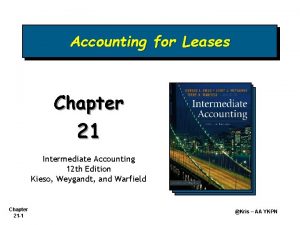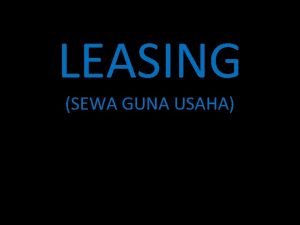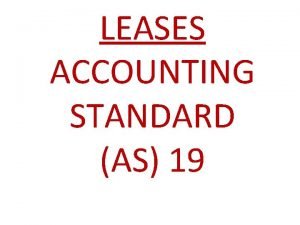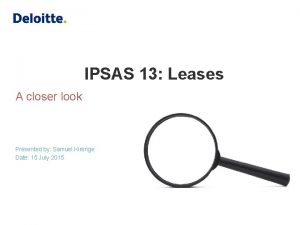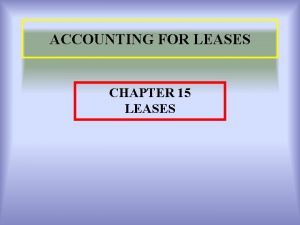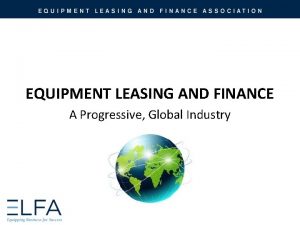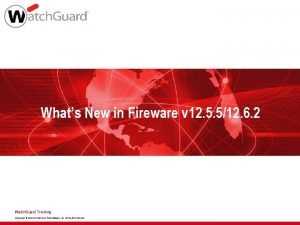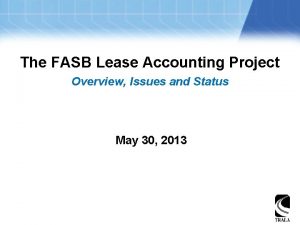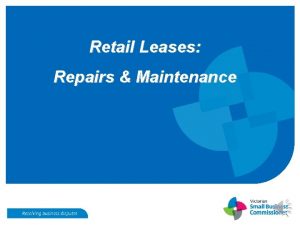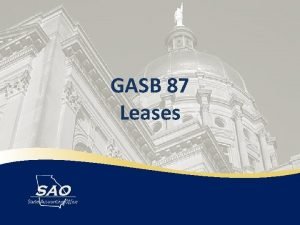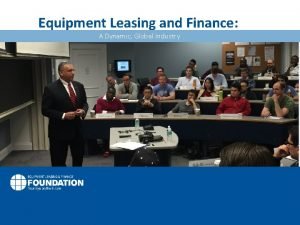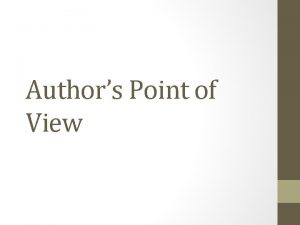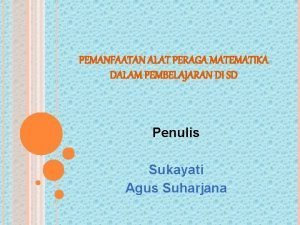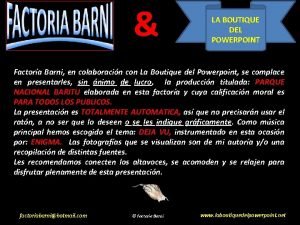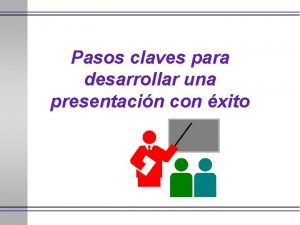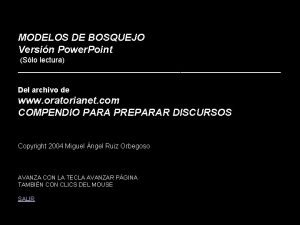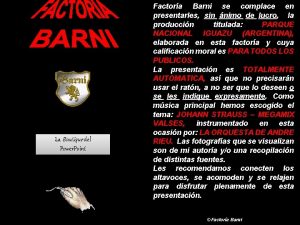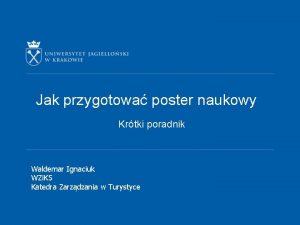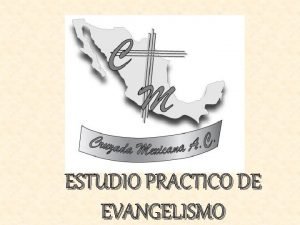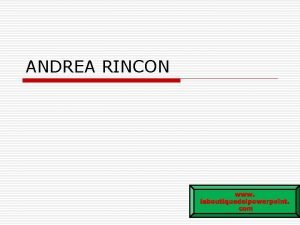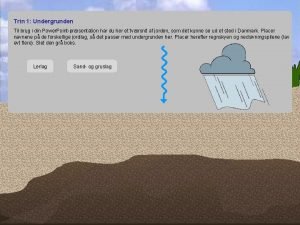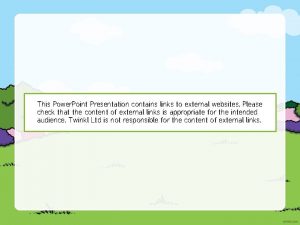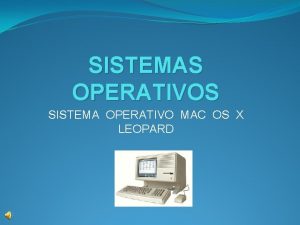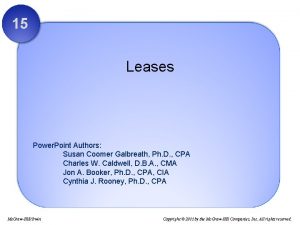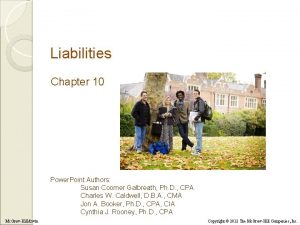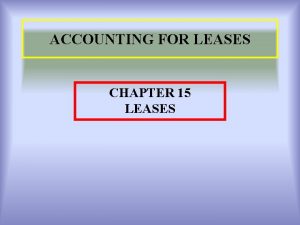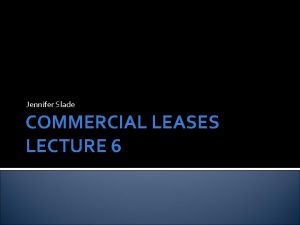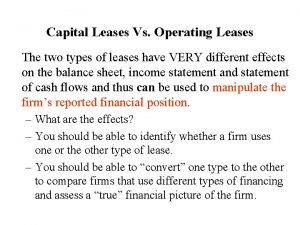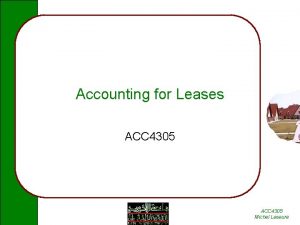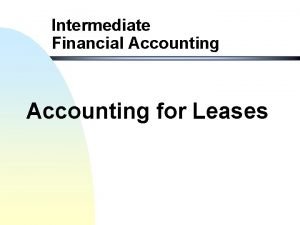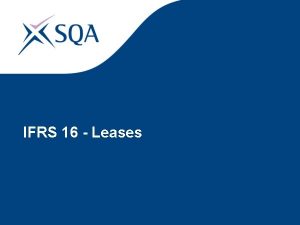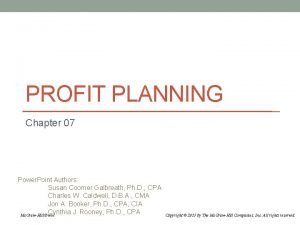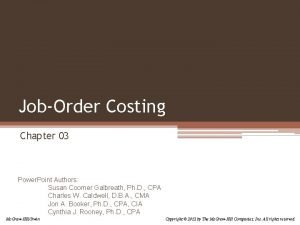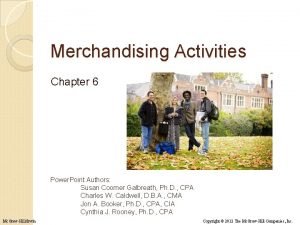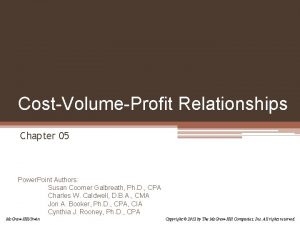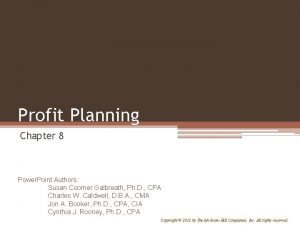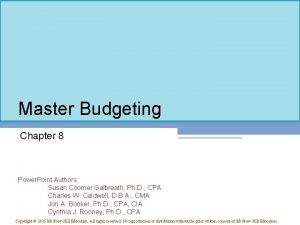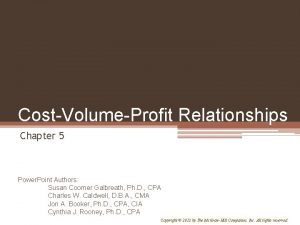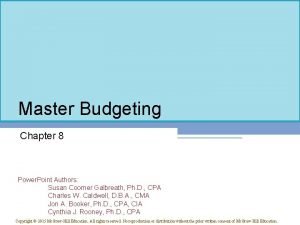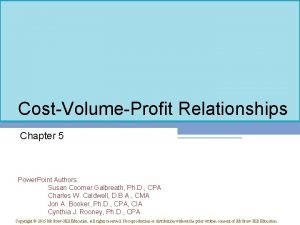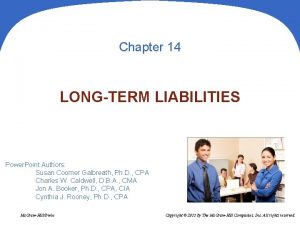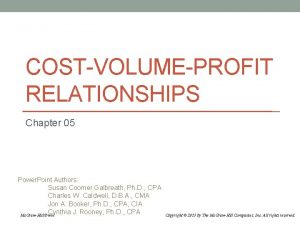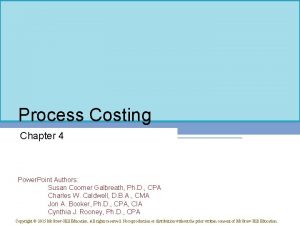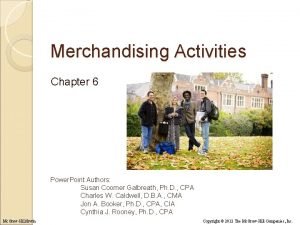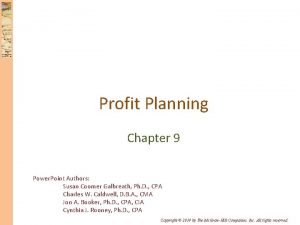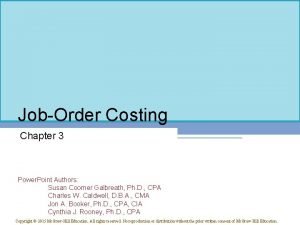Leases Chapter 15 Power Point Authors Susan Coomer















































![15 -48 Second Lease Payment [Dec. 31, 2013] Effective Rate Outstanding Balance 15 -48 Second Lease Payment [Dec. 31, 2013] Effective Rate Outstanding Balance](https://slidetodoc.com/presentation_image/5e3abb59730a39081838258461fa10ce/image-48.jpg)





![15 -54 Second Lease Payment [Dec. 31, 2013] Outstanding Balance Effective Rate 15 -54 Second Lease Payment [Dec. 31, 2013] Outstanding Balance Effective Rate](https://slidetodoc.com/presentation_image/5e3abb59730a39081838258461fa10ce/image-54.jpg)





















- Slides: 75

Leases Chapter 15 Power. Point Authors: Susan Coomer Galbreath, Ph. D. , CPA Charles W. Caldwell, D. B. A. , CMA Jon A. Booker, Ph. D. , CPA, CIA Cynthia J. Rooney, Ph. D. , CPA Copyright © 2013 by The Mc. Graw-Hill Companies, Inc. All rights reserved.

15 -2 Accounting by the Lessor and Lessee A lease is an agreement in which the lessor conveys the right to use property, plant, or equipment, usually for a stated period of time, to the lessee. Lessee = Renter Lessor = Owner of property

Capital Leases and Installment Notes Compared Matrix, Inc. acquires equipment from Apex, Inc. by paying $193, 878 every 6 months for the next 3 years. The interest rate associated with the agreement is 9%. Let’s look at the arrangement as an installment note payable and as a capital lease agreement. First, let’s prepare an amortization schedule for the payments. 15 -3

15 -4 Inception of the Agreement At inception January 1 Installment Note Equipment Notes payable 1, 000, 000 Capital Leased equipment Lease payable 1, 000, 000

15 -5 Classification Criteria Operating Lease Capital Lease A capital lease must meet one of four criteria: capital lease one Ownership transfers to the lessee at the end of the lease term, or. . . A bargain purchase option (BPO) exists, or. . . A The noncancelable lease term is equal to 75% or The noncancelable lease term is equal to more of the expected economic life of the asset, or The PV of the minimum lease payments is 90% or The PV of the minimum lease payments is more of the fair value of the asset.

15 -6 Classification Criteria Operating Lease Capital Lease A capital lease must meet one of four criteria: capital lease one Ownership transfers to the lessee at the end of the lease term, or. . . A bargain purchase option (BPO) exists, or. . . A The noncancelable lease term is equal to 75% or The noncancelable lease term is equal to more of the expected economic life of the asset, or The PV of the minimum lease payments is 90% or The PV of the minimum lease payments is more of the fair value of the asset.

15 -7 Classification Criteria A bargain purchase option (BPO) gives the lessee the A right to purchase the leased asset at a price significantly lower than the expected fair value of the property and the exercise of the option appears reasonably assured. The lease term is normally considered to be the non. The cancelable term of the lease plus any periods covered by bargain renewal options. If the inception of the lease occurs during the last 25% of an asset’s economic life, this criterion does not apply. For the lessee, a capital lease is treated as the purchase of an asset – the lessee records both an asset and liability at inception of the lease.

15 -8 Additional Lessor Conditions The four conditions discussed apply to both the lessee and lessor. However, the lessor must meet two additional conditions for the lease to be classified as either a direct financing or sales-type lease: 1. The collectibility of the lease payments must be reasonably predictable. 2. If any costs to the lessor have yet to be incurred, they are reasonably predictable. Performance by the lessor is substantially complete. Lessor = Owner of the property subject to the lease.

15 -9 U. S. GAAP vs. IFRS

15 -10 Operating Leases Lease agreement exists. Record lease as an Operating Lease. Criteria for a capital lease not met. Capital Lease

15 -11 Operating Leases On January 1, 2013, Sans Serif Publishers, Inc. , a computer services and printing firm, leased printing equipment from First Lease. Corp. The lease agreement specifies four annual payments of $100, 000 beginning January 1, 2013, the inception of the lease, and at each January 1 thereafter through 2016. The useful life of the equipment is estimated to be six years. Before deciding to lease, Sans Serif considered purchasing the equipment for its cash price of $479, 079. If funds were borrowed to buy the equipment, the interest rate would have been 10%. At the End of Four Payment Dates San Serif Publishers, Inc. (Lessee) Prepaid rent 100, 000 Cash 100, 000 First Lease. Corp (Lessor) Cash Unearned rent revenue 100, 000

15 -12 Leasehold Improvements Sometimes a lessee will make improvements to leased property that reverts back to the lessor at the end of the lease. Like other assets, leasehold improvement costs are allocated as depreciation expense over its useful life to the lessee, which is to be the shorter of the physical life of the asset or the lease term.

15 -13 Capital Leases – Lessee and Lessor The amount recorded (capitalized) is the present value of the minimum lease payments. However, the amount recorded cannot exceed the fair value of the leased asset. In calculating the present value of the minimum lease payments, the interest rate used by the lessee is the lower of: 1. Its incremental borrowing rate, or 2. The implicit interest rate used by the lessor.

15 -14 Capital Leases – Lessee and Lessor If the lessor is not a manufacturer or dealer, the fair value of the leased asset typically is the lessor’s cost. When the lessor is a manufacturer or dealer, the fair value of the property at the inception of the lease is likely to be its normal selling price.

15 -15 Capital Leases – Lessee and Lessor On January 1, 2013, Sans Serif Publishers, Inc. , leased printing equipment from First Lease Corp. First Lease purchased the equipment from Compu. Dec Corporation at a cost of $479, 079. The lease agreement specifies annual payments beginning January 1, 2013, $479, 079 ÷ 4. 79079* = $100, 000 payments. *PV of an annuity due of $1: n = 6, I = 10% the inception of the lease, and at each December 31 thereafter through 2017. The six year lease term ending December 31, 2018, is equal to the estimated useful life of the copier. $100, 000 × 4, 79079* = $479, 079 lessee’s cost First Lease routinely acquires electronic equipment for lease to other firms. The interest rate In these financing arrangements is 10%. Since the lease term is equal to the expected useful life of the equipment (>75%), the transaction must be recorded by the lessee as a capital lease We believe the collectibility of the lease payments is reasonably certain and any costs to the lessor that are yet incurred are reasonably predictable, this qualifies also as a direct financing lease to First Lease. To achieve its direct financing lease objectives, First Lease must (a) recover its $479, 079 investment as well as (b) earn interest revenue at a rate of 10%. So, the lessor determined that annual rental payments would be $100, 000.

15 -16 Capital Leases – Lessee and Lessor Direct Financing Lease (January 1, 2013) Sans Serif Publishers, Inc. (Lessee) Leased equipment (PV of payments) Lease payable (PV of payments) 479, 079 First Lease. Corp. (Lessor) Lease receivable (PV of payments) 479, 079 Inventory of equipment (Lessor’s cost) 479, 079 First Lease Payment (January 1, 2013) Sans Serif Publishers, Inc. (Lessee) Lease payable Cash 100, 000 First Lease. Corp. (Lessor) Cash Lease receivable 100, 000

15 -17 Capital Leases – Lessee and Lessor Amortization Schedule for the Lease $379, 079 × 10% = $37, 908 $100, 000 - $37, 908 = $62, 092 $379, 079 - $62, 092 = $316, 987

15 -18 Capital Leases – Lessee and Lessor Second Lease Payment (December 31, 2013) Sans Serif Publishers, Inc. (Lessee) Interest expense Lease payable Cash First Lease. Corp. (Lessor) Cash Lease receivable Interest revenue 37, 908 62, 092 100, 000 62, 092 37, 908 Depreciation Recorded at (December 31, 2013) Sans Serif Publishers, Inc. (Lessee) Depreciation expense Accumulated depreciation 79, 847 ($479, 079 ÷ 6 = $79, 847 Assuming straight-line method. )

15 -19 Capital Leases – Lessee and Lessor Depreciation Period The lessee normally should depreciate a leased asset over the term of the lease. However, if ownership transfers or a bargain purchase option is present (i. e. , either of the first two classification criteria is met), the asset should be depreciated over its useful life.

15 -20 Sales-Type Leases If the lessor is a manufacturer or dealer, the fair value of the leased asset generally is higher than the cost of the asset. At inception of the lease, the lessor will record the cost of goods sold as well as the sales revenue (PV of payments). In addition to interest revenue earned over the lease term, the lessor receives a manufacturer’s or dealer’s profit on the “sale” of the asset.

15 -21 Sales-Type Leases On January 1, 2013, Sans Serif Publishers, Inc. , leased printing equipment from Compu. Dec Corp. at a price of $479, 079. The lease agreement specifies annual payments of $100, 000 beginning January 1, 2013 (the inception of the lease), and at each December 31 thereafter through 2017. The six-year lease term ending December 31, 2018, is equal to the estimated useful life of the equipment. Compu. Dec manufactured the equipment at a cost of $300, 000. Compu. Dec’s interest rate for financing the transaction is 10%.

15 -22 Sales-Type Leases Lease Classification 1. The lease term (6 -years) is equal to 100% of the useful life of the copier, and 2. Fair market value is different from cost of the leased asset. 3. Compu. Dec is certain about the collectibility of the lease payments, and 4. No costs are to be incurred by Compu. Dec relating to the lease agreement, SO The lease agreement is classified as a sales-type lease from the viewpoint of Compu. Dec (lessor) and a capital lease from the viewpoint of Sans Serif Publishers (lessee).

15 -23 Sales-Type Leases: Lessee At Inception of the Lease – January 1, 2013 Compu. Dec Corp. (Lessor) Lease receivable Cost of goods sold Sales revenue Inventory of equipment 479, 079 300, 000 479, 079 300, 000 Receipt of the First Lease Payment – January 1, 2013 Compu. Dec Corp. (Lessor) Cash Lease receivable 100, 000

Bargain Purchase Options and Residual Value A bargain purchase option (BPO) is a provision of some lease contracts that gives the lessee the option of purchasing the leased property at a bargain price. The expectation that the option price will be paid effectively adds an additional cash flow to the lease for both the lessee and the lessor. As a result: LESSEE adds the present value of the BPO price to the present value of periodic rental payments when computing the amount to be recorded a leased asset and a lease liability. LESSOR, when computing periodic rental payments, subtracts the present value of the BPO price from the amount to be recovered (fair value) to determine the amount that must be recovered from the lessee through the periodic rental payments. 15 -24

15 -25 Bargain Purchase Option (BPO) On January 1, 2013, Sans Serif Publishers, Inc. , leased printing equipment from Compu. Dec Corporation at a price of $479, 079. The lease agreement specifies annual payments beginning January 1, 2013, the inception of the lease, and at each December 31 there after through 2017. The estimated useful life of the equipment is seven years. On December 31, 2018, at the end of the six-year lease term, the equipment is expected to be worth $75, 000, and Sans Serif has the option to purchase it for $60, 000 on that date. The residual value after seven years is zero. Compu. Dec manufactured the equipment at a cost of $300, 000 and its interest rate for financing the transaction is 10%.

15 -26 Bargain Purchase Option (BPO) Exercise of BPO at the end of the lease term: $54, 542 × 10% = $5, 458* $60, 000 BPO payment - $5, 458 = $54, 542

15 -27 Bargain Purchase Option (BPO) End of Lease – December 31, 2017 Sans Serif Publishers, Inc. (Lessee) Depreciation expense ($479, 079 ÷ 7) Accumulated depreciation Interest expense Lease payable Cash (BPO payment) Compu. Dec Corporation(Lessor) Cash Lease receivable Interest revenue Refer the amortization schedule and computations on the previous screen 68, 440 5, 458 54, 542 60, 000 54, 582 5, 458

15 -28 Residual Value The residual value of leased property is an estimate of what its commercial value will be at the end of the lease term. On January 1, 2013, Sans Serif Publishers, Inc. , leased printing equipment from Compu. Dec Corporation at a price of $479, 079. The lease agreement specifies annual payments beginning January 1, 2013, the inception of the lease, and at each December 31 thereafter through 2017. The estimated useful life of the equipment is seven years. At the end of the six-year lease term, ending December 31, 2018, the equipment is expected to be worth $60, 000. Compu. Dec manufactured the equipment at a cost of $300, 000 and its interest rate for financing the transaction is 10%.

15 -29 Effect on the Lessee of a Residual Value Guaranteed Residual Value Sometimes the lease agreement includes a guarantee by the lessee that the lessor will recover a specified residual value when custody of the asset reverts back to the lessor at the end of the lease term. This not only reduces the lessor’s risk but also provides incentive for the lessee to exercise a higher degree of care in maintaining the leased asset to preserve the residual value. PV factor of an annuity due of $1: n=6, i=10% PV factor of $1: n=6, i=10%

15 -30 Effect on the Lessee of a Residual Value Unguaranteed Residual Value A lease agreement may be silent as to the question of residual value. This is referred to as an unguaranteed residual value. In the case of unguaranteed residual value, the lessee is not obligated to make any payments other than the periodic rental payments. As a result, the present value of the minimum lease payments — recorded as a leased asset and a lease liability — is simply the present value of periodic rental payments ($445, 211). The same is true when the residual value is guaranteed by a third-party guarantor such as an insurance company.

15 -31 Effects on the Lessor of a Residual Value Guaranteed Residual Value When the residual value is guaranteed, the lessor as well as the lessee views it as a component of minimum lease payments. In fact, even if it is not guaranteed, the lessor still expects to receive it in the form of property, or cash, or both.

15 -32 Residual Value Guaranteed Let’s use our previous example of a sales-type lease and replace the bargain purchase option with a guaranteed residual value. Sales-Type Lease – January 1, 2013 Sans Serif Publishers, Inc. (Lessee) Leased equipment 479, 079 Lease payable 479, 079 Compu. Dec Corporation (Lessor) Lease receivable 479, 079 Cost of goods sold 300, 000 Sales revenue 479, 079 Inventory of equipment 300, 000

15 -33 Residual Value Guaranteed First Lease Payment – January 1, 2013 Sans Serif Publishers, Inc. (Lessee) Lease payable 92, 931 Cash 92, 931 Compu. Dec Corporation (Lessor) Cash 92, 931 Lease receivable 92, 931

15 -34 Residual Value Guaranteed December 31, 2017 Sans Serif Publishers, Inc. (Lessee) Depreciation expense 69, 847 Accumulation depreciation 69, 847 Interest expense Lease payable Cash 13, 407 79, 524 92, 931 Compu. Dec Corporation (Lessor) Cash 92, 931 Interest revenue 13, 407 Lease receivable 79, 524 See amortization schedule

15 -35 Treatment of Residual Value

15 -36 Executory Costs One of the responsibilities of ownership that is transferred to the lessee in a capital lease is the responsibility to pay for maintenance, insurance, taxes, and any other costs associated with ownership. These are referred to as executory costs The lessee records executory costs as incurred: Sans Serif Publishers, Inc. (Lessee) Maintenance expense 2, 000 Cash 2, 000

15 -37 Discount Rate One rate is implicit in the lease agreement. This is the effective interest rate the lease payments provide the lessor over and above the price at which the asset is sold under the lease. It is the desired rate of return the lessor has in mind when deciding the size of the lease payments. Usually the lessee is aware of the lessor’s implicit rate or can infer it from the asset’s fair value. When the lessor’s implicit rate is unknown, the lessee should use its own incremental borrowing rate. This is the rate the lessee would expect to pay a bank if funds were borrowed to buy the asset.

15 -38 Lessor’s Initial Direct Costs Incremental costs incurred by the lessor in negotiating and consummating a lease agreement. Operating Leases − Capitalize and amortize over the lease term by the lessor. Direct Financing Leases − Include as part of investment balance. Sales-Type Leases – The initial direct costs are expensed at the inception of the lease.

15 -39 Contingent Rentals Sometimes rental payments may be increased (or decreased) at some future time during the lease term, depending on whether some specified event occurs. Contingent rentals are not included in the minimum lease payments. However, they are disclosed in the notes to the financial statements.

15 -40 Lease Disclosures Lease disclosure requirements are quite extensive for both the lessor and lessee. Virtually all aspects of the lease agreement must be disclosed. For all leases (a) a general description of the leasing arrangement is required as well as (b) minimum future payments, in the aggregate and for each of the five succeeding fiscal years.

15 -41 Lease Disclosures The lessor must disclose its net investment in the lease. This amount is the present value of the gross investment in the lease, which is the total of the minimum lease payments (plus any unguaranteed residual value). Other required disclosures are specific to the type of lease and include residual values, contingent rentals, sublease rentals, and executory costs.

Balance Sheet and Income Statement 15 -42 Lease transactions impact several financial ratios 1. Debt to equity ratio – Lease liabilities are recorded. 2. Rate of return on assets – Lease assets are recorded. Whether leases are capitalized or treated as an operating lease affects the income statement and balance sheet. The greater impact is on the balance sheet.

15 -43 Special Leasing Arrangements 1. Sale-Leaseback Arrangements – the owner of an asset sells it and immediately leases it back from the new owner. Any gain on the sale of the asset is deferred and amortized. A real loss on the sale of the property is recognized immediately. 2. Real Estate Leases: • Leases of Land Only • Leases of Land Building • Leases of Only Part of a Building

Summary of the Proposed Lease Standard Update

15 -45 Leases: Where We’re Headed The FASB and the IASB are collaborating on a joint Exposure Draft of the new leases standard update. Even after the proposed Accounting Standard Update (proposed ASU) is issued, previous GAAP will be relevant until the proposed ASU becomes effective (likely not mandatory before 2016) and students taking the CPA or CMA exams will be responsible for the previous GAAP until six months after that effective date. Conversely, prior to the effective date of the proposed Accounting Standard Update it is useful for soon-to-be graduates to have an understanding of the new guidance on the horizon. In the right-of-use model introduced in the proposed standards update, all leases are recorded as an asset and liability (with the exception of short term leases as described later), and the concept of operating leases is eliminated.

15 -46 Right-of-Use Model

15 -47 Lessee and Lessor Entries
![15 48 Second Lease Payment Dec 31 2013 Effective Rate Outstanding Balance 15 -48 Second Lease Payment [Dec. 31, 2013] Effective Rate Outstanding Balance](https://slidetodoc.com/presentation_image/5e3abb59730a39081838258461fa10ce/image-48.jpg)
15 -48 Second Lease Payment [Dec. 31, 2013] Effective Rate Outstanding Balance

15 -49 Lease Amortization Schedule 0 No interest yet; no time has passed.

Amortization of the Right-of-Use Asset (Lessee) v The lessee amortizes its right-of-use asset over lease term (or the useful life of the asset if it’s shorter). v Using the asset results in an expense for the lessee. 15 -50

15 -51 When the Lessor Retains a Residual Asset On January 1, 2013, Sans Serif Publishers leased printing equipment from First Lease. Corp who purchased the equipment from Compu. Dec Corporation at its fair value of $479, 079. Now assume [ 4 annual payments of $100, 000 beginning January 1, 2013, and at each December 31 through 2015. [ Useful life of the equipment is 6 years. [ Lessor calculated payments using a rate of 10%.

15 -52 When the Lessor Retains a Residual Asset Commencement of Lease [Jan. 1, 2013] Only a portion of the right to use the asset is being transferred. Accordingly, a portion is being retained. The portion transferred is:

15 -53 When the Lessor Retains a Residual Asset
![15 54 Second Lease Payment Dec 31 2013 Outstanding Balance Effective Rate 15 -54 Second Lease Payment [Dec. 31, 2013] Outstanding Balance Effective Rate](https://slidetodoc.com/presentation_image/5e3abb59730a39081838258461fa10ce/image-54.jpg)
15 -54 Second Lease Payment [Dec. 31, 2013] Outstanding Balance Effective Rate

15 -55 Lease Amortization Schedule 0 No interest yet; no time has passed.

Lessee: Amortization of ROU Asset Lessor: Accretion of the Residual Asset The lessee incurs an expense as it uses the asset. The lessor will record accretion of the residual asset using the interest rate implicit in the agreement (10%). 15 -56

15 -57 Accretion? Why? Consider this: To determine the lease payments, the lessor subtracts from fair value the present value of the four-years-away residual value: Asset’s residual value at end of 4 -yr lease term How does the lessor recover its $479, 079 investment?

15 -58 Accretion? Why? So, First Lease. Corp expects to recover its $479, 079 investment as follows: v At commencement of the lease, the lessor recorded its residual asset at $130, 394. At the end of the lease term, that amount will have risen to $190, 911. The process of increasing the asset’s balance is called accretion. Since $130, 394 is the PV of $190, 911 discounted at 10%, the balance (PV) will increase annually by 10%.

15 -59 Accretion? Why? The residual asset accretes at the 10% discount rate to its anticipated value at the end of the lease term: First Lease. Corp earns a 10% rate of return on both the portion of its asset transferred (interest revenue) and the portion retained as a residual asset (accretion revenue).

Lease’s Effect on the Income of Lessee And Lessor The residual asset accretes at the 10% discount rate to its anticipated value at the end of the lease term: 15 -60

15 -61 When the Lessor Earns a Profit from the Lease Ø Ø All lessor entries other than this one, which now includes the profit, are precisely the same as when there is no profit. Accounting by the lessee is not affected by how the lessor records the lease.

When the Lessor Earns a Profit and Retains a Residual Asset 15 -62

When the Lessor Earns a Profit and Retains a Residual Asset 6 payments of $88, 218; asset’s cost $300, 000; FV $479, 079. The equipment is expected to have a fair value of $100, 000 at lease end. 15 -63

15 -64 Accretion of the Residual Asset When there is profit in a lease, the carrying amount of the residual asset (the $35, 347 portion of the equipment retained) is less than the fair value of the residual asset ($56, 447). The difference ($56, 447 – 35, 347 = $21, 100) is the deferred profit on the portion of the asset not transferred. To record accretion of the residual asset from its current fair value to its anticipated fair value at the end of the lease term, first increase the balance of the residual asset from its carrying amount to its current fair value at the commencement of the lease: We also can view the deferred profit as the portion of the total profit if the equipment were to have been transferred in its entirety minus the profit actually recognized currently: Total profit (479, 079 – 300, 000) $179, 079 Less: Profit recognized at commencement (157, 979) Deferred profit $ 21, 100

15 -65 Accretion of the Residual Asset Compu. Dec will report a “net residual asset” in the balance sheet, which is the “gross residual asset” offset by the deferred profit. So, initially the reportable amount is: But since the gross amount is accreted (increased) over the term of the lease, the reported amount (equal to the gross amount minus deferred profit) increases as well.

15 -66 Accretion of the Residual Asset The balance in the gross residual asset accretes at the 10% discount rate to its anticipated value at the end of the lease term.

15 -67 Accretion of the Residual Asset To help visualize the relationship among the different ways to measure the residual asset as of the commencement of the lease:

15 -68 Summary of Lessee / Lessor Accounting Lessee Right-of-use asset (present value of payments) Lease liability (present value of payments) xxx Lessor Lease receivable (present value of payments) xxx Residual asset (carrying amount of portion retained, if any *) Asset (carrying amount: derecognized) xxx Profit (difference, if any, between the PV of lease payments and the carrying amount transferred*) xx xx * Carrying amount of asset x [Lease receivable / Fair value of asset] = Amount transferred Carrying amount of asset – Amount transferred = Residual asset * In the rare instance that this is a debit difference, we would have a loss rather than profit. Also, only recognize profit if it is “reasonably assured”. Otherwise, defer and recognize over life of lease.

15 -69 Discount Rate In calculating the PV of the payments, the discount rate used by the lessee is: The rate the lessor charges the lessee (rate that causes the sum of PV of lease payments and the PV of the residual value of the underlying asset to equal the fair value of the asset today). • If the lessor’s rate is not known, use the lessee’s incremental borrowing rate.

15 -70 Initial Direct Costs v Costs associated directly with originating a lease that would not have been incurred had the lease agreement not occurred are. v Include legal fees, commissions, evaluating the prospective lessee’s financial condition, and preparing and processing lease documents. v Added to the carrying amount of the right-ofuse asset if incurred by the lessee or to the lease receivable if incurred by the lessor.

15 -71 What if the Lease Term is Uncertain? Ø The lease term is the non-cancellable period, plus any options where there is a “significant economic incentive” to extend or not terminate the lease. Ø Factors that might create an economic incentive for the lessee include bargain renewal rates, penalty payments for cancellation or non-renewal and economic penalties such as significant customization or installment costs.

15 -72 What if the Lease Payments are Uncertain? Lease payments include: Ø payments that depend on an index or rate (e. g. , increase with inflation rate) Ø contingent payments that are “reasonably assured. ”

15 -73 Guaranteed Residual Value q If a cash payment under a lessee-guaranteed residual value is predicted, the present value of that payment is added to the present value of the lease payments the lessee records as both a right-of-use asset and a lease liability. q Likewise, it also adds to the amount that the lessor records as a lease receivable. q It is simply seen as an additional lease payment.

15 -74 Short-Term Leases – A Short-Cut Method Ø A lease that has a maximum possible lease term (including any options to renew) of 12 months or less is a “short-term lease. ” Ø Lease-by-lease option to choose a short-cut approach. Lessee can elect: vnot to recognize a right-of-use asset or a lease liability. vto recognize lease payments as expense over the lease term. Lessor can elect: vnot to record the lease receivable or to derecognize the asset being leased. vto recognize lease payments as revenue over the lease term.

15 -75 End of Chapter 15
 Intermediate accounting leases
Intermediate accounting leases Chapter 21 accounting for leases kieso terjemahan
Chapter 21 accounting for leases kieso terjemahan Real power formula
Real power formula Informsu
Informsu Leases adalah
Leases adalah As 19 accounting standard
As 19 accounting standard Ipsas leases
Ipsas leases Lessor versus lessee
Lessor versus lessee Pvmlp leases
Pvmlp leases Trac leases asc 842
Trac leases asc 842 Ias 17 leases
Ias 17 leases View dhcp leases watchguard system manager
View dhcp leases watchguard system manager Lease accounting project
Lease accounting project Ifrsbox leases
Ifrsbox leases Section 52 retail leases act
Section 52 retail leases act Gasb 62 leases
Gasb 62 leases Operating lease
Operating lease Ias 17 finance lease criteria
Ias 17 finance lease criteria Point point power
Point point power Authors point of view
Authors point of view What is the author's point of view
What is the author's point of view Solar power satellites and microwave power transmission
Solar power satellites and microwave power transmission Potential power
Potential power Flex power power supply
Flex power power supply The dispersive power of a grating is defined as the
The dispersive power of a grating is defined as the Power of a power property
Power of a power property General power rule
General power rule Power angle curve in power system stability
Power angle curve in power system stability Power absorbed or delivered
Power absorbed or delivered Evangelio del domingo en power point
Evangelio del domingo en power point Como hacer un ova
Como hacer un ova La boutique del power point
La boutique del power point Powerpoint tennis
Powerpoint tennis Tm pp
Tm pp Power point sul riciclo in inglese
Power point sul riciclo in inglese Proposal alat peraga matematika
Proposal alat peraga matematika Sekolah sabat powerpoint 2021
Sekolah sabat powerpoint 2021 La boutique del powerpoint x
La boutique del powerpoint x La boutique del power point
La boutique del power point La boutique del power point
La boutique del power point La boutique del powerpoint
La boutique del powerpoint Animasi terima kasih power point bergerak
Animasi terima kasih power point bergerak Decreto 1330 de 2019 ppt
Decreto 1330 de 2019 ppt Powerpoint
Powerpoint Portafolio digital estudiantil ejemplo
Portafolio digital estudiantil ejemplo Cara mengoperasikan microsoft power point
Cara mengoperasikan microsoft power point Como poner potencias en power point
Como poner potencias en power point What are the advantages of microsoft powerpoint
What are the advantages of microsoft powerpoint Ventajas y desventajas de power point
Ventajas y desventajas de power point Presentazione power point tesina
Presentazione power point tesina La boutique del power point x
La boutique del power point x Rambu-rambu penyusunan materi ajar
Rambu-rambu penyusunan materi ajar Power point fisica
Power point fisica Power point
Power point Concentrese en power point
Concentrese en power point Bosquejo de lectura
Bosquejo de lectura Egizi ppt
Egizi ppt La boutique del powerpoint
La boutique del powerpoint La boutique del powerpoints
La boutique del powerpoints La boutique del power point x
La boutique del power point x Power point
Power point La boutique del powerpoint
La boutique del powerpoint Apocalipsis la bestia 666
Apocalipsis la bestia 666 Poster naukowy
Poster naukowy Quatrain
Quatrain La importancia del evangelismo
La importancia del evangelismo Ventajas y desventajas de usar power point
Ventajas y desventajas de usar power point Power point
Power point Www.laboutiquedelpowerpoint.com
Www.laboutiquedelpowerpoint.com Powerpoint 2002
Powerpoint 2002 Komunikacja interpersonalna prezentacja power point
Komunikacja interpersonalna prezentacja power point Plantillas de powerpoint
Plantillas de powerpoint Grundvandspejlet
Grundvandspejlet Power point ethernet
Power point ethernet Power point links
Power point links Desventajas de mac os
Desventajas de mac os

